Anazarbus
Anazarbus (Ancient Greek: Ἀναζαρβός, medieval Ain Zarba; modern Anavarza; Arabic: عَيْنُ زَرْبَة) was an ancient Cilician city. Under the late Roman Empire, it was the capital of Cilicia Secunda. Roman emperor Justin I rebuilt the city in 527 after a strong earthquake hit it. It was destroyed in 1374 by the forces of Mamluk Empire, after their conquest of Armenia.
Anavarza (in Turkish) | |
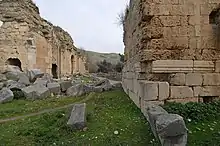 The triumphal arch of Anazarbus was later converted to the city's South Gate. | |
 Shown within Turkey | |
| Alternative name | Caesarea, Justinopolis |
|---|---|
| Location | Adana Province, Turkey |
| Region | Cilicia |
| Coordinates | 37°15′50″N 35°54′20″E |
| Type | Settlement |
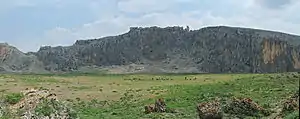

Location
It was situated in Anatolia in modern Turkey, in the present Çukurova (or classical Aleian plain) about 15 km west of the main stream of the present Ceyhan River (or classical Pyramus river) and near its tributary the Sempas Su.
A lofty isolated ridge formed its acropolis. Though some of the masonry in the ruins is certainly pre-Roman, the Suda's identification of it with Cyinda, famous as a treasure city in the wars of Eumenes of Cardia, cannot be accepted in the face of Strabo's express location of Cyinda in western Cilicia.[1]
History
It was founded by Assyrians. It was situated on the Pyramus. According to the Suda, the original name of the place was Cyinda or Kyinda or Quinda (Greek: Κύϊνδα); that it was next called Diocaesarea.[2] How the city obtained the name Anazarbus (Ἀνάζαρβος) or Anazarba (Ἀνάζαρβα), as it was also known, is a matter of conjecture. According to Stephanus of Byzantium, after the city was destroyed by an earthquake, the emperor Nerva sent thither one Anazarbus, a man of senatorial rank, who rebuilt the city, and gave to it his own name.[3] This account cannot be accurate, as Valesius remarks,[4] for it was called Anazarbus in Pliny's time.[5] Dioscorides is called a native of Anazarbus; but the period of Dioscorides is not certain. It was also the home of the poet Oppian. Its later name was Caesarea ad Anazarbum, and there are many medals of the place in which it is both named Anazarbus and Caesarea at or under Anazarbus. On the division of Cilicia it became the chief place of the Roman province of Cilicia Secunda, with the title of Metropolis. It suffered dreadfully from an earthquake both in the time of Eastern Roman emperor Justinian I, and, still more, in the reign of his successor Justin I. After Justinian rebuilt the place, it was renamed Justinianopolis or Ioustinianoupolis (Ἰουστινιανούπολις). Rebuilt by Justin I after the earthquake in the 6th century, it became Justinopolis or Ioustinoupolis (Ἰουστινούπολις) (525); but the old name persisted, and when Thoros I, king of Lesser Armenia, made it his capital early in the 12th century, it was known as Anazarva.
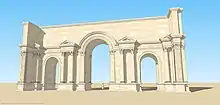
Remains
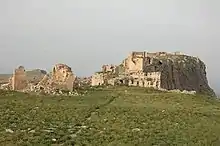

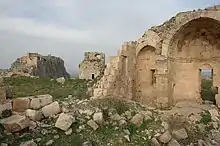
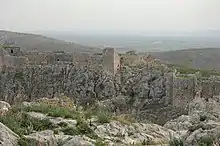
Its great natural strength and situation, not far from the mouth of the Sis pass, and near the great road which debouched from the Cilician Gates, made Anazarbus play a considerable part in the struggles between the Eastern Roman Empire and the early Muslim invaders. It had been rebuilt by Harun al-Rashid in 796, refortified at great expense by the Hamdanid Sayf al-Dawla[1] (mid-10th century) and again destroyed in 962 by Nikephoros II Phokas.
In late 1097 or early 1098 it was captured by the armies of the First Crusade and was incorporated into Bohemond's Principality of Antioch. The Crusaders are probably responsible for the construction of an impressive donjon atop the center of the outcrop. Most of the remaining fortifications, including the curtain walls, massive horse-shaped towers, undercrofts, cisterns, and free-standing structures date from the Armenian periods of occupation, which began with the arrival of the Rubenid Baron T‛oros I, c. 1111.[6] The site briefly exchanged hands between the Greeks and Armenians, until it was formally part of the Armenian Kingdom of Cilicia. Within the fortress are two Armenian chapels and the magnificent (but severely damaged) three-aisle church built by T‛oros I to celebrate his conquests.[7][8] The church was once surrounded by a continuous, well-executed dedicatory inscription in Armenian.
The Mamluk Empire of Egypt finally destroyed the city in 1374.
The present wall of the lower city is of late construction. It encloses a mass of ruins conspicuous in which are a fine triumphal arch, the colonnades of two streets, a gymnasium, etc. A stadium and a theatre lie outside the walls to the south. The remains of the acropolis fortifications are very interesting, including roads and ditches hewn in the rock. There are no notable structures in the upper town. For picturesqueness the site is not equaled in Cilicia, and it is worthwhile to trace the three fine aqueducts to their sources.[1] A necropolis on the escarpment to the south of the curtain wall can also be seen complete with signs of illegal modern excavations.
A visit in December 2002 showed that the three aqueducts mentioned above have been nearly completely destroyed. Only small, isolated sections are left standing with the largest portion lying in a pile of rubble that stretches the length of where the aqueducts once stood. A powerful earthquake that struck the area in 1945 is thought to be responsible for the destruction.
A modest Turkish farming village (Dilekkaya) lies to the southwest of the ancient city. A small outdoor museum with some of the artifacts collected in the area can be viewed for a small fee. Also nearby are some beautiful mosaics discovered in a farmers field. Inquire at the museum for a viewing.
Anazarbus/Anavarsa was one of a chain of Armenian fortifications stretching through Cilicia. The castle of Sis (modern Kozan, Adana) lies to the north while Tumlu Castle and Yilankale are to the south, and the fortresses of Amouda and Sarvandikar are to the east.
In 2013, excavations uncovered the first known colonnaded double-lane road of the ancient world, 34 meters wide and 2700 meters long, also uncovered the ruins of a church and a bathhouse.[9]
In 2017, archaeologists discovered a limestone statue of the goddess Hygieia and the god Eros. The statue is thought to date to the third or fourth century B.C.[9]
Ecclesiastical history
Anazarbus was the capital and so also from 553 (the date of the Second Council of Constantinople) the metropolitan see of the Late Roman province of Cilicia Secunda.[10][11]
In the 4th century, one of the bishops of Anazarbus was Athanasius, a "consistent expounder of the theology of Arius." His theological opponent, Athanasius of Alexandria, in De Synodis 17, 1 refers to Anazarbus as Ναζαρβῶν.[12]
Maximin of Anazarbus attended the Council of Chalcedon.[13][14]
A 6th century Notitia Episcopatuum indicates that it had as suffragan sees Epiphania, Alexandria Minor, Irenopolis, Flavias, Castabala and Aegeae. Rhosus was also subject to Anazarbus, but after the 6th century was made exempt, and Mopsuestia was raised to the rank of autcephalous metropolitan see, though without suffragans.[15][16][17][18]
Latin Catholic titular see
The titular archbishopric was revived in the 18th century as a see of the Latin Catholic church, Anazarbus.[19]
It is vacant, having had the following incumbents, generally of the highest (Metropolitan) rank, with an episcopal (lowest rank) exception :
- Titular Archbishop Giuseppe Maria Saporiti (1726.04.08 – 1743.12.02)
- Titular Bishop Isidro Alfonso Cavanillas (1753.04.09 – 1755.05.12)
- Titular Archbishop Gerolamo Formagliari (1760.07.21 – 1781)
- Titular Archbishop Romain-Frédéric Gallard (1839.02.21 – 1839.09.28)
- Titular Archbishop [[Antoine Pierre [Andon Bedros] Hassoun]] (1842.06.07 – 1846.08.02), as Coadjutor Archeparch of Istanbul of the Armenians (Turkey) (1842.06.07 – 1846.08.02), succeeded as Archeparch of Istanbul of the Armenians (Turkey) (1846.08.02 – 1866.09.14), later Patriarch of Cilicia of the Armenians (Lebanon) ([1866.09.14] 1867.07.12 – 1881.06), created Cardinal-Priest of Ss. Vitale, Valeria, Gervasio e Protasio (1880.12.16 – 1884.02.28)
- Titular Archbishop Giorgio Labella, Friars Minor (O.F.M.) (1847.06.04 – 1860.10.27)
- Titular Archbishop Charles Petre Eyre (1868.12.03 – 1878.03.15)
- Titular Archbishop John Baptist Salpointe (1884.04.22 – 1885.08.18)
- Titular Archbishop Michael Logue (1887.04.19 – 1887.12.03) (later Cardinal)*
- Titular Archbishop François Laurencin (1888.06.01 – 1892.12.18)
- Titular Archbishop Joaquín Larraín Gandarillas (1893.06.15 – 1897.09.26)
- Titular Archbishop Raimondo Ingheo (1907.12.16 – 1911.07.08)
- Titular Archbishop Cláudio José Gonçalves Ponce de Leon, Lazarists (C.M.) (1912.01.09 – 1924.05.26)
- Titular Archbishop Raymund Netzhammer, Benedictine Order(] O.S.B.) (1924.07.14 – 1945.09.18)
- Titular Archbishop Michele Akras (1945.10.27 – 1947.02.05)
- Titular Archbishop Heinrich Döring (ハインリヒ・デーリング), S.J. (1948.01.15 – 1951.12.17)
- Titular Archbishop Joseph-Marie Le Gouaze (1955.06.24 – 1964.07.31)
Armenian Catholic titular see
In the 19th century, an Armenian Catholic titular bishopric of Anazarbus (of the Armenians) (Anazarbus degli Armeniin Curiate Italian) was established.
It was a suppressed in 1933,[20] having had a single incumbent, of the intermediary (archiepiscopal) rank :
- Titular Archbishop Avedis Arpiarian (1898.04.05 – 1911.08.27), previously Eparch of Kharput of the Armenians (1890.09.23 – 1898.04.05); later Eparch of Marasc of the Armenians (1911.08.27 – 1928.06.29), Auxiliary Eparch of the patriarchate Cilicia of the Armenians (Lebanon) (1928.06.29 – 1931.10.17), Armenian Catholic Patriarch of Cilicia (Lebanon) ([1931.10.17] 1933.03.13 – 1937.10.26)
Notable locals
- Pedanius Dioscorides (1st century) Greek physician, pharmacologist and botanist
- St. Domnina of Anazarbus[21]
- St. Theodula of Anazarbus[22]
| Wikimedia Commons has media related to Anazarbus. |
See also
References
Citations
-
 One or more of the preceding sentences incorporates text from a publication now in the public domain: Hogarth, David George (1911). "Anazarbus". In Chisholm, Hugh (ed.). Encyclopædia Britannica. 1 (11th ed.). Cambridge University Press. p. 944.
One or more of the preceding sentences incorporates text from a publication now in the public domain: Hogarth, David George (1911). "Anazarbus". In Chisholm, Hugh (ed.). Encyclopædia Britannica. 1 (11th ed.). Cambridge University Press. p. 944. - Suda, s.v. Κύϊνδα.
- Stephanus of Byzantium. Ethnica. s.v. Ἀνάζαρβος.
- Amm. Marc. 14.8.
- Pliny. Naturalis Historia. 5.27.
- Edwards, Robert W. (1987). The Fortifications of Armenian Cilicia: Dumbarton Oaks Studies XXIII. Washington, D.C.: Dumbarton Oaks, Trustees for Harvard University. pp. 65–72, 281, pls.9a–18b, 287b–289c. ISBN 0-88402-163-7.
- Robert W. Edwards, "Ecclesiastical Architecture in the Fortifications of Armenian Cilicia: First Report, Dumbarton Oaks Papers 36, 1982, pp.156–61, 168, pls.1–7.
- Robert W. Edwards, "Ecclesiastical Architecture in the Fortifications of Armenian Cilicia: Second Report, Dumbarton Oaks Papers 37, 1983, pp.128–34, pls.2, 18–29, 36–46.
- Statue of Hygieia and Eros uncovered in southern Turkey
- Edwards, Robert W., "Anazarbos" (2016). The Eerdmans Encyclopedia of Early Christian Art and Archaeology, ed., Paul Corby Finney. Grand Rapids, Michigan: William B. Eerdmans Publishing. pp. 57–58. ISBN 978-0-8028-9016-0.
- Oriens christianus: in quatuor patriarchatus digestus : quo exhibentur ... by Michel Le Quien ((O.P.)), Oriens christianus (ex Typographia Regia, 1740) p40.
- R. P. C. Hanson, The Search for the Christian Doctrine of God: The Arian Controversy 318-381 (Edinburgh: T & T Clark, 1988), 41-3, quote, 43.
- The Cannons of the two hundred Holy and Blessed Fathers who met at Ephesus.
- Charles Joseph Hefele, A History of the Councils of the Church: from the Original Documents, to the close of the Second Council of Nicaea A.D. 787 (Wipf and Stock Publishers, 1 February 2007) page 151.
- Michel Le Quien, Oriens christianus in quatuor Patriarchatus digestus, Paris 1740, Vol. II, coll. 885–888
- Gaetano Moroni, Dizionario di erudizione storico-ecclesiastica, Vol. 2, pp. 40–41
- Siméon Vailhé, v. Anazarbe, in Dictionnaire d'Histoire et de Géographie ecclésiastiques, vol. II, Paris 1914, coll. 1504–1506
- Echos d'Orient 1907, p. 95.
- Annuario Pontificio 2013 (Libreria Editrice Vaticana 2013 ISBN 978-88-209-9070-1).
- Hierarchia Catholica Medii et Recentioris Aevi, Volume 8, Page 99, and Page 328.
- Domina of Anazarbus.
- St. Theodula of Anazarbus in Cilicia.
General references
- Entry for Anazarbus from the Suda.
![]() This article incorporates text from a publication now in the public domain: Smith, William, ed. (1854–1857). "Anazarbus". Dictionary of Greek and Roman Geography. London: John Murray.
This article incorporates text from a publication now in the public domain: Smith, William, ed. (1854–1857). "Anazarbus". Dictionary of Greek and Roman Geography. London: John Murray.
External links
- GCatholic Latin titular see
- GCatholic Armenian Catholic former titular see
- Carefully documented photographic survey and plan of Anazarbus Castle
